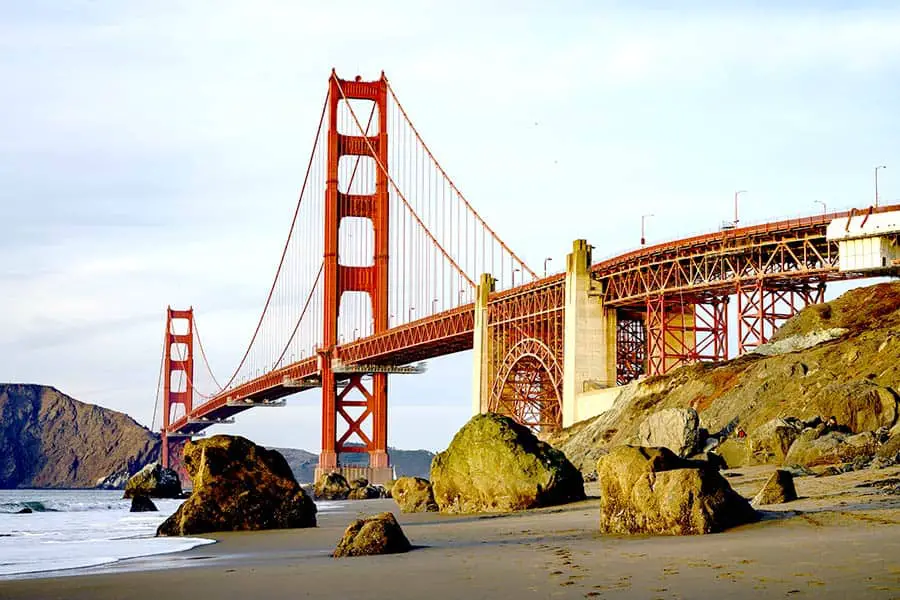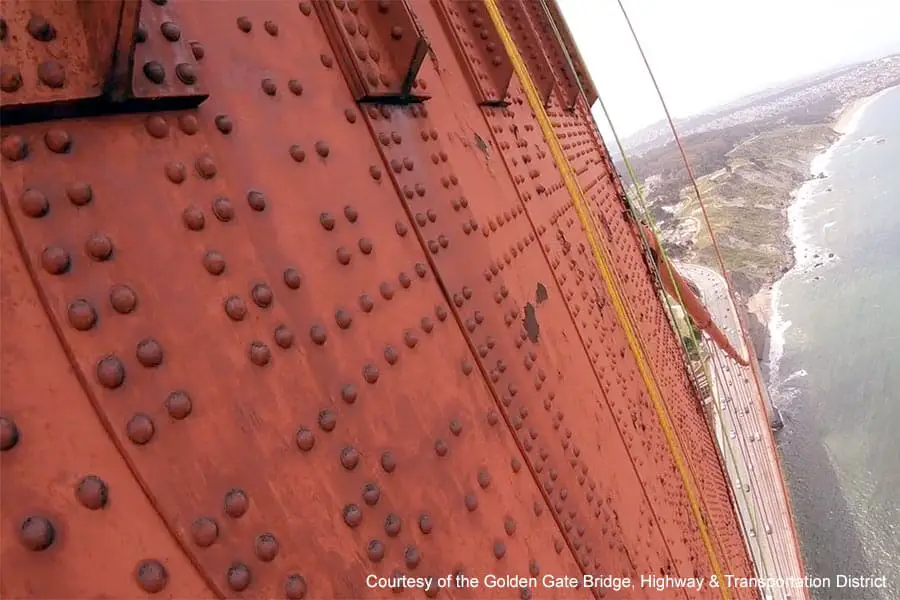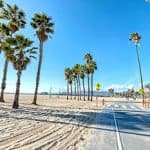
The Golden Gate Bridge is a unique and impressive structure that’s one of the most instantly recognizable icons in the world. Thousands of people come to San Francisco each year simply to bask in awe of its soaring towers, its magnificent views, and its unmistakable color. But what exactly is that color? Is it red? Is it gold? The answer is somewhere in between.
The steel used to construct the bridge had a surface coat of red lead primer that the bridge’s architectural team thought blended perfectly with the surrounding natural landscape and helped the bridge stand out in the fog. The team then mixed paints to create the bridge’s signature color, officially known as “International Orange.”
The story of the bridge’s color goes much deeper than that, and if the U.S. War Department had had their way, the bridge would have been painted in black and yellow stripes! Let’s take a look at a colorful part of San Francisco history by going deeper into the bridge’s construction and how that crazy color came to be.
Building the Golden Gate Bridge

The story of how the Golden Gate Bridge’s color came to be is tied to how the bridge itself came to be. Construction of a much-needed span across the Golden Gate Strait began in 1933 and lasted four years. Upon its opening in 1937, it was both the tallest and the longest suspension bridge in the world, with a main span of 4,200 feet and a total height of 746 feet. See more historic photos here.
While San Franciscans were enthusiastic about the prospect of a new bridge, opposition from many fronts, including the U.S. War Department, almost kept the bridge from being built at all. There were concerns over costs (projected to be $100 million, an astronomical figure at the time), design, security, and whether a bridge, no matter how well designed, could withstand the fierce tides, strong winds, dense fog, and extreme salt air of the Golden Gate Strait. The reality that the San Andreas Fault is only seven inland miles away also raised red flags.
As well, local ferry companies fiercely opposed a bridge that would seriously impact their business and profits, as ferries were the only way to cross the strait at the time. Their fierce anti-bridge campaign would succeed for eight years until it became inevitable that a bridge would indeed be built across the Golden Gate Strait.
Once a budget was accepted, and funds were raised, the four-year process of building the Golden Gate Bridge, overseen by chief engineer Joseph Strauss, went smoothly until its much-ballyhooed opening on May 27, 1937. Despite initial concerns about overall construction costs, building the bridge eventually cost $35 million ($523 million in 2021 dollars), which was $1.3 million under budget. The construction was also completed months ahead of schedule.
Choosing the Golden Gate Bridge Paint – A Colorful Decision

While the bridge was being built, consulting architect Irving F. Morrow, who was also instrumental in coming up with the bridge’s lighting and signature art-deco design, noticed that steel imported from Bethlehem Steel in Pennsylvania was coated with a reddish-orange primer that protected it from corrosion. He liked how the color stood out in the fog and how it meshed with the surrounding topography of the Golden Gate Strait and Marin Headlands.
Preferring this vivid primer hue over the more conventional bridge paint choices of carbon black and steel gray, he and his team mixed paints to come up with a color that approximated that original red primer. The result was the iconic International Orange that now distinguishes the Golden Gate Bridge from (almost) every other bridge in the world. But convincing the U.S. Department of War and the bridge’s board of directors, the permitting agencies at the time, to make such an unusual color permanent would prove to be a challenge.
Bay Area Answers Fun Fact: In order to better increase its visibility, the Golden Gate Bridge International Orange tone is slightly lighter than the standard International Orange. This eye-catching color is also used by the Tokyo Tower in Japan and the 25 de Abril Bridge in Lisbon, Portugal, which is affectionately known as “the Golden Gate Bridge’s twin sister.”
Morrow made his best case in 1935 when he presented a 29-page report on the reasonings for the color to the bridge’s board of directors. In it, he wrote, “The Golden Gate Bridge is one of the greatest monuments of all time. Its unprecedented size and scale, along with its grace of form and independence of conception, all call for unique and unconventional treatment from every point of view. What has been thus played up in form should not be let down in color.”
While locals might say that’s spoken like a true San Franciscan, his impassioned plea for creativity worked, and the rest, as they say, is history, as International Orange went from relative obscurity to one of the most recognizable paint colors in the world. Here are a few other tidbits about the bridge’s color:
It’s Not Gold
One misconception is that the bridge’s color is gold; after all, it’s in the name! Another is that it has something to do with the 1849 California Gold Rush, which occurred 90 years before the bridge opened. Neither is true, as the “gold” in “Golden Gate” is because the bridge spans the Golden Gate Strait, the 3-mile long and one-mile wide body of water that separates San Francisco from Marin County and connects the San Francisco Bay with the Pacific Ocean.
Other Posts Of Interest:
- How Many Bridges Are in the San Francisco Bay Area?
- How Long Does It Take to Walk Across the Golden Gate Bridge?
- Are There Sharks in San Francisco Bay?
- Is San Francisco Expensive for Tourists?
About Those Stripes
The U.S. War Department was against constructing a bridge across the strait, fearing enemy bombing or a collapse of the bridge that could trap U.S. warships inside the Bay. They eventually gave approval but not without demanding that the bridge be painted in black and yellow stripes to improve its visibility. At the same time, the Army Air Corps pushed for red and white stripes, which would be more noticeable from the air but make the bridge look like a giant candy cane. Fortunately, more creative minds prevailed.
How Often Is the Paint Maintained?
Another myth of the Golden Gate Bridge is that it is regularly repainted to keep the color vivid. The reality is repainting all 10 million square feet of the bridge would take years, even with a large team of painters working non-stop. While maintenance and touch-ups are done on a regular on-going basis, mostly to maintain the color and to protect it from wind and salt air, the bridge has not been fully repainted since the 1980s when a saltwater-resistant topcoat was applied.
Who Paints the Golden Gate Bridge?

The bridge employs a paint supervisor who oversees a team of about thirty structural painters. The team works almost continuously to maintain the bridge color; only rain keeps them from their duties. It’s not an easy job, as workers must deal with a dense fog that envelopes the bridge 70 percent of the time, frigid temperatures, and fierce 60 MPH winds that would be challenging for anyone, let alone painters using spray guns. Around 5,000 to 10,000 gallons of paint are used yearly to touch-up the Golden Gate Bridge.
Can You Buy International Orange?
If you love the Golden Gate Bridge so much that you want to paint your house the same color, you’re in luck. The paint formula for International Orange is no secret, and paint stores can easily mix it for you.
While it might not be the exact International Orange used to paint the bridge (that’s a special mixture formulated just for the bridge). However, you can come close with some existing color codes.
- PMS 173 (CYMK = 0%, 80%, 94%, 1%)
- PMS 174 (CYMK 8%, 85%, 100%, 34%)
- Pantone 180 (CYMK 19.4%, 77.9%, 79.6%, 3.6%)
Buying paint for the Golden Gate Bridge is done through a competitive bidding process. The paint is currently supplied by Sherwin Williams and is made to match the Golden Gate Bridge International Orange color formula. The closest available off-the-shelf paint color is “Fireweed” (color code SW 6328).
All Things Considered
It just seems to make sense that a city that prides itself on its quirky individualism would be home to a bridge that’s like no other. Maybe it’s the trippy color or the art deco design, but there’s something about the Golden Gate Bridge that screams, “San Francisco!” While other bridges might have more modern, innovative designs, none can match the Golden Gate Bridge’s mystique. If you’ve seen it, you know what that means. If you haven’t, what are you waiting for?





